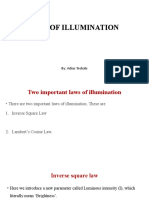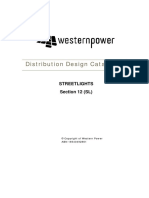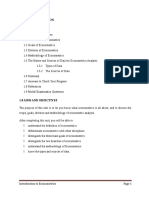Diversity Factor: by Sintayehu Challa
Diversity Factor: by Sintayehu Challa
Uploaded by
Tesfahun GirmaOriginal Description:
Original Title
Copyright
Available Formats
Share this document
Did you find this document useful?
Is this content inappropriate?
Report this DocumentCopyright:
Available Formats
Diversity Factor: by Sintayehu Challa
Diversity Factor: by Sintayehu Challa
Uploaded by
Tesfahun GirmaCopyright:
Available Formats
Diversity Factor
The diversity factor has an important place in the design of an installation and its final costing. IEE
regulation 311-01 deals with the subject. Diversity factor is a factor which is applied to sub main and
main cables and their associated gears/ circuit breakers to reduce:
a) the cross sectional area of the cable conductor, and
b) the capacity of the switch gears/ circuit breakers.
The factor is based on the assumption that the whole of the connected load will not be turned on at
the same time. For example, the total lighting load in a dwelling house is rarely switched on at a time.
Thus, it can be taken that if the total lighting load is 1000W during the life of the installation, only 66%
of the load (660W) will be switched on at any one time. The factor in this instance is 0.66. A factor for
diversity shall not be allowed for calculating the size of circuit conductor and switchgears of final sub
circuits, other than specified circuits such as cooker circuits. It is noted that the provision of an allowance
for diversity is a matter of calling for a special knowledge and experience. Indeed, the application of the
diversity should be decided by the engineer responsible for designing each particular installation. The
amount by which they are increased or decreased for each installation is a matter for the installation
engineer to decide.
There are ten types of final circuit fed from wiring to which diversity applies: lighting, heating,
cooking appliances which are permanently connected, motors (other than lifting motors), instantaneous-
type water heater, thermostatically controlled water heater, floor-warming installation, thermal-storage
space-heating installation, 13A fused socket outlets and appliance fed there from, and other socket
outlets such as 15A sockets. Three general groups of installation premises are also recognized:
1) Individual domestic installation, including individual flats of a block.
2) Hotels, boarding houses, lodging houses etc.
3) Shops, stores, offices and business premises
In the case of lighting for each type of installation, it will be noticed that the more the total lighting
load is likely to switched on over definite periods, the smaller is the allowance made for diversity. In a
domestic installation, it is estimated that some two-thirds (0.66) of the lighting load will be on at any one
time. In a hotel, the figure is 75%(0.75), and in a shop, where virtually all the lights are on for most of
the time when the shop is open, the figure is 90% (0.90). It should be noted that no diversity is allowable
in the relevant wiring supplying certain types of load.
Example: An apartment having 15 individual rooms each 9mX4m (see figure
below) is to be installed with the following loads: Ventilator (500W), Fridge
(1kW), Stove (2kW), six 60W lamps, and five socket outlets.
a) Locate the approximate area of location of each lamps and socket outlets.
b) Calculate the sub-feeder cable size for this room if the average ambient temperature of
the local area is taken as 38oC and five groups of circuits are running together in a Fig 1 Floor Plan for the above example
conduit with it. The length of run is 15m and protection is by MCB.
c) Choose the rating of the MCB and the branch circuits breakers.
By Sintayehu Challa
You might also like
- Social Networking Usage QuestionnaireDocument2 pagesSocial Networking Usage Questionnaireerin louise94% (18)
- eFIXX Maximum Demand and DiversityDocument38 pageseFIXX Maximum Demand and DiversityJustin SheehanNo ratings yet
- Elec2134 NotesDocument95 pagesElec2134 NotesJason HaNo ratings yet
- Electrical Installation Ppt1Document27 pagesElectrical Installation Ppt1Abrha Ftsum100% (1)
- Sheet 1 Pelton WheelDocument2 pagesSheet 1 Pelton WheelAbdelmoneimFawzy100% (1)
- Unit 4: Cable: Distribution Design SystemDocument24 pagesUnit 4: Cable: Distribution Design SystemScalper0% (1)
- RoboticAutomatic Tool Changer PDFDocument36 pagesRoboticAutomatic Tool Changer PDFTesfahun GirmaNo ratings yet
- New Chapter Four LastDocument36 pagesNew Chapter Four LastephremNo ratings yet
- 2012Ch1 Supple NotesDocument12 pages2012Ch1 Supple Notesskywalker_handsomeNo ratings yet
- Wollega University College of Engineering and Technology: Electrical InstallationsDocument36 pagesWollega University College of Engineering and Technology: Electrical InstallationsAmos KormeNo ratings yet
- IP Telephony (Metro Tel)Document13 pagesIP Telephony (Metro Tel)Shohel ShikdarNo ratings yet
- 2500DA Engine Data SheetDocument3 pages2500DA Engine Data SheetNiraj ReginaldNo ratings yet
- Telecommunications Technology Fundamentals: III-1 TransmissionDocument24 pagesTelecommunications Technology Fundamentals: III-1 Transmissionkheyrto foodareNo ratings yet
- Electrical Building FacilitiesDocument19 pagesElectrical Building FacilitiesJose Antonio Salazar HidalgoNo ratings yet
- Energy Research Center BrochureDocument2 pagesEnergy Research Center Brochureamer4411No ratings yet
- Electrical Design Report For G+1 Residential Building: Owner: Marta TemsgenDocument8 pagesElectrical Design Report For G+1 Residential Building: Owner: Marta TemsgenFitsum Tadesse100% (2)
- Electrical Design ReportDocument12 pagesElectrical Design ReportAtse Mandela100% (1)
- HandOut CH3Document33 pagesHandOut CH3Ělîâȟ Gṫȓ Gûângûl67% (3)
- Effective ApertureDocument2 pagesEffective ApertureCatherine ProtasNo ratings yet
- Design and Implementation of An Energy-Saving Lighting Control System Considering User SatisfactionDocument8 pagesDesign and Implementation of An Energy-Saving Lighting Control System Considering User SatisfactionDébora Thomé MirandaNo ratings yet
- Chapter 2Document23 pagesChapter 2Melkamu BirlewNo ratings yet
- Table 4D1A Single Core PVCDocument1 pageTable 4D1A Single Core PVCDarren KhooNo ratings yet
- Ring EarthingDocument3 pagesRing EarthingJibin J VargheseNo ratings yet
- Chapter 3Document19 pagesChapter 3Lëlîså DébālkéNo ratings yet
- Module 2.1Document38 pagesModule 2.1JASPER PAYAPAYANo ratings yet
- Telephone Network System Part 1Document109 pagesTelephone Network System Part 1MelvirNo ratings yet
- Chapter 3 InstalletionDocument38 pagesChapter 3 InstalletionTesfahun LukasNo ratings yet
- Electrical Engineering Lab IV (ECEG-3207) EXAMDocument2 pagesElectrical Engineering Lab IV (ECEG-3207) EXAMmigadNo ratings yet
- Chapter 4 - PresentationeeeeeeDocument79 pagesChapter 4 - PresentationeeeeeeyeabmotherNo ratings yet
- IlluminationDocument130 pagesIlluminationsavvymovNo ratings yet
- Calculux RoadDocument41 pagesCalculux RoadBello Ahmed Bello100% (1)
- Electrical Load Estimation - Part Two Electrical KnowhowDocument1 pageElectrical Load Estimation - Part Two Electrical KnowhowSintayehu TerefeNo ratings yet
- Building Telephone Facilities, Structured Cabling, IP PBXDocument51 pagesBuilding Telephone Facilities, Structured Cabling, IP PBXjericson019No ratings yet
- Problem Based Learning: Roll Number: 19ES31Document8 pagesProblem Based Learning: Roll Number: 19ES31Qurban AliNo ratings yet
- Automatic Street Light Control ReportDocument14 pagesAutomatic Street Light Control ReportSarath Kumar KmrNo ratings yet
- Feeder PillarDocument2 pagesFeeder PillarSeindahNyaNo ratings yet
- DC Motor Lecture 3Document27 pagesDC Motor Lecture 3Fira tubeNo ratings yet
- Requirement For LightingDocument60 pagesRequirement For LightingAhmedNo ratings yet
- A Thermal Model For PV SystemsDocument11 pagesA Thermal Model For PV SystemsSyamimi SaadonNo ratings yet
- Inverse Square & Cosine LawDocument12 pagesInverse Square & Cosine LawAdisu0% (1)
- GECOL Design Guide Line For PlanningDocument21 pagesGECOL Design Guide Line For PlanningSerajNo ratings yet
- Installation Chapter 3Document102 pagesInstallation Chapter 3tazeb100% (4)
- Building Services - ThermodynamicsDocument108 pagesBuilding Services - ThermodynamicsDevansh MehtaNo ratings yet
- Network HandoutDocument151 pagesNetwork HandoutLeti TadesseNo ratings yet
- Tribhuvan University: Institute of EngineeringDocument10 pagesTribhuvan University: Institute of EngineeringDipak KhadkaNo ratings yet
- EuroTray KatologDocument268 pagesEuroTray KatologummanNo ratings yet
- Lecture - 4 - Artificial - Lighting - CalculationDocument40 pagesLecture - 4 - Artificial - Lighting - Calculationsamuel seyoumNo ratings yet
- Chapter 3Document46 pagesChapter 3Tewodros ShegawNo ratings yet
- Elec. InstallationDocument8 pagesElec. InstallationabellNo ratings yet
- Tutorial 4 CT VTDocument3 pagesTutorial 4 CT VTEyad A. FeilatNo ratings yet
- Chapter 3-Lighting Scheme and Bell CircuitsDocument89 pagesChapter 3-Lighting Scheme and Bell CircuitsyeabmotherNo ratings yet
- Electrical Installation Design: Terminology and DefinitionsDocument27 pagesElectrical Installation Design: Terminology and DefinitionsMirkena kebede100% (1)
- Eet 10 Lighting Technology and Methods of CalculationDocument10 pagesEet 10 Lighting Technology and Methods of CalculationLinus AbokiNo ratings yet
- Chapter 3 Feeder DesignDocument26 pagesChapter 3 Feeder Designfitwi halefom100% (1)
- Demand FactorDocument37 pagesDemand FactoruddinnadeemNo ratings yet
- 11-Step Procedure For A Successful Electrical Circuit Design (Low Voltage)Document7 pages11-Step Procedure For A Successful Electrical Circuit Design (Low Voltage)Mohammad Ather SiddiquiNo ratings yet
- Demand FactorDocument23 pagesDemand FactorVic Diaco100% (1)
- Designing Inherently Short-Circuit-Proof, Potted Safety Transformers Up To 10VA With Rale Design System, in Accordance With IEC 61558Document15 pagesDesigning Inherently Short-Circuit-Proof, Potted Safety Transformers Up To 10VA With Rale Design System, in Accordance With IEC 61558PredragPeđaMarkovićNo ratings yet
- 11-Step Procedure For A Successful Electrical Circuit Design (Low Voltage)Document11 pages11-Step Procedure For A Successful Electrical Circuit Design (Low Voltage)kisan singhNo ratings yet
- Tsewg Tp-11 Ufc 3-500-10n Best PracticesDocument7 pagesTsewg Tp-11 Ufc 3-500-10n Best PracticeshopkitNo ratings yet
- Streetlight Standards Book PDFDocument73 pagesStreetlight Standards Book PDFSRINIVAS KALYANNo ratings yet
- Street LightingDocument10 pagesStreet LightingJoseEliasSanchezQuezadaNo ratings yet
- Pole CatalogueDocument19 pagesPole CatalogueTesfahun GirmaNo ratings yet
- Calculate Street Light Pole's Distance - Fixture Watt - Lighting Area - Electrical Notes & ArticlesDocument9 pagesCalculate Street Light Pole's Distance - Fixture Watt - Lighting Area - Electrical Notes & ArticlesTesfahun Girma100% (1)
- Highway LED IlluminationDocument120 pagesHighway LED IlluminationTesfahun GirmaNo ratings yet
- Calculate Street Light Pole's Distance - Fixture Watt - Lighting Area - Electrical Notes & ArticlesDocument9 pagesCalculate Street Light Pole's Distance - Fixture Watt - Lighting Area - Electrical Notes & ArticlesTesfahun Girma100% (1)
- Roadway Lighting Design Methodology and EvaluationDocument24 pagesRoadway Lighting Design Methodology and EvaluationTesfahun GirmaNo ratings yet
- Distribution Design Catalogue Streetlights 20180820Document97 pagesDistribution Design Catalogue Streetlights 20180820Tesfahun GirmaNo ratings yet
- Distribution Design Catalogue Streetlights 20180820Document97 pagesDistribution Design Catalogue Streetlights 20180820Tesfahun GirmaNo ratings yet
- Dharmendra Kumar Singh Fire Alarm DESEDocument24 pagesDharmendra Kumar Singh Fire Alarm DESETesfahun GirmaNo ratings yet
- Street Light Trans Design Manual Appendix A 2021Document11 pagesStreet Light Trans Design Manual Appendix A 2021Tesfahun GirmaNo ratings yet
- Guide To Light Levels PDFDocument1 pageGuide To Light Levels PDFTesfahun GirmaNo ratings yet
- Fill Ratio 12-10Document2 pagesFill Ratio 12-10Tesfahun GirmaNo ratings yet
- Earthing and TestingDocument8 pagesEarthing and TestingTesfahun GirmaNo ratings yet
- Xlpe Insulated Cables Need Power ConnectDocument32 pagesXlpe Insulated Cables Need Power ConnectTesfahun GirmaNo ratings yet
- Guidance On Energy AuditsDocument6 pagesGuidance On Energy AuditsTesfahun Girma100% (1)
- S1 近似值與數值估算 (Approximate Values and Numerical Estimation) - V2 - Final - GDocument19 pagesS1 近似值與數值估算 (Approximate Values and Numerical Estimation) - V2 - Final - G丛头越No ratings yet
- SVL Automatic Stirrup MachineDocument8 pagesSVL Automatic Stirrup MachineSVL CONSTRUCTION EQUIPMENTSNo ratings yet
- Gadget AddictionDocument8 pagesGadget AddictionkNo ratings yet
- Econometrics Module 2Document185 pagesEconometrics Module 2Neway Alem100% (1)
- Module 1 Personal Development - PH Facilitator's Manual - FINALDocument41 pagesModule 1 Personal Development - PH Facilitator's Manual - FINALValerie AriesVirgoNo ratings yet
- 04 Catalogue Material Testing 19-02-2021Document43 pages04 Catalogue Material Testing 19-02-2021Martin BarrientosNo ratings yet
- Power Hour Research INDUSTRY K-HudsDocument16 pagesPower Hour Research INDUSTRY K-HudsJorge Robledo MorenoNo ratings yet
- Oct 21 Captions Photos InterviewsDocument3 pagesOct 21 Captions Photos Interviewsapi-239208620No ratings yet
- Investing Across SectorsDocument44 pagesInvesting Across SectorsJoy AcostaNo ratings yet
- مراحل تطبيق إعادة هندسة العمليات (الهندرة) دراسة تطبيقية على بنك الفلاحة والتنمية الريفيةDocument23 pagesمراحل تطبيق إعادة هندسة العمليات (الهندرة) دراسة تطبيقية على بنك الفلاحة والتنمية الريفيةbouchra benfadel100% (1)
- High-Density Polyethylene Foams. I. Poly PDFDocument9 pagesHigh-Density Polyethylene Foams. I. Poly PDFamirsuryahidayahNo ratings yet
- StsDocument8 pagesStsDevendrasinh JadejaNo ratings yet
- Earth Life 11 Q2 M12Document15 pagesEarth Life 11 Q2 M12John Benedict CUSTODIANo ratings yet
- Terms of Reference - Labour-Sharing Steering CommitteeDocument3 pagesTerms of Reference - Labour-Sharing Steering CommitteeNEAREDB_commsNo ratings yet
- Common ConstantsDocument3 pagesCommon Constantskristan7No ratings yet
- Powershell Interview Questions and Answers: Find Out Which Server and Services Are Running Under A Specific AccountDocument4 pagesPowershell Interview Questions and Answers: Find Out Which Server and Services Are Running Under A Specific AccountCyb3rAlienNo ratings yet
- Daily Preference SoapDocument22 pagesDaily Preference SoapkalaivaniNo ratings yet
- The Atlas of The New LibrarianshipDocument263 pagesThe Atlas of The New LibrarianshipKeke Ferreira100% (1)
- C1 - May - 05 Model SolutionDocument18 pagesC1 - May - 05 Model SolutionAFRAH ANEESNo ratings yet
- 1st Stage - Validation Checklist ID For Garda VettingDocument2 pages1st Stage - Validation Checklist ID For Garda VettingPraxedes PxNo ratings yet
- Li9Yc (ST) 11Y 4X2X0.15 GN: Leoni Special Cables GMBHDocument2 pagesLi9Yc (ST) 11Y 4X2X0.15 GN: Leoni Special Cables GMBHLeodoletaNo ratings yet
- RFP 800 KVA TransformerDocument9 pagesRFP 800 KVA TransformerDejen HaileslassieNo ratings yet
- Dissection QuizDocument5 pagesDissection QuizACHRAF KADMIRINo ratings yet
- Answer Les CopaqueDocument26 pagesAnswer Les CopaqueAinul MardhiyahNo ratings yet
- CRM in Insurance CompaniesDocument4 pagesCRM in Insurance CompaniesBig BugNo ratings yet
- ISSE Midwest 2012 Preshow BrochureDocument52 pagesISSE Midwest 2012 Preshow BrochureprobeautyassociationNo ratings yet
- Analyzing Survey QuestionnairesDocument16 pagesAnalyzing Survey QuestionnairesBenny DuongNo ratings yet
- FSM in VHDLDocument10 pagesFSM in VHDLkunalsekhri123No ratings yet
- Food Energy Pyramid Do Now ReadingDocument2 pagesFood Energy Pyramid Do Now Readingapi-291011460No ratings yet








































































































